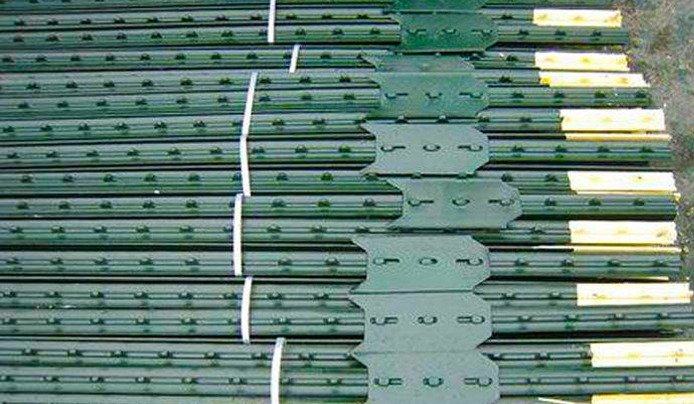Studded T-Posts Are Perfect For Staking Tomatoes
Studded T-posts are perfect for staking tomatoes. But don’t take my word for it, not so fast! Continue reading as I make my case for what I think may be the premium staking method, not just for your heirloom tomatoes, but any tomato garden! I am really writing this article as a testimony as to how studded T-posts have made my life much easier since I started using them in my tomato gardens.
I remember the days when I was a young tomato grower back in the Caribbean. To be honest, I can’t even remember using stakes, yet we always got good harvests. But I now know that if I hope to realize the best potential form my tomato plants, proper staking is imperative!
Four Popular Types Of Tomato Stakes
Metal Tomato Cages
One of the most popular type of tomato staking methods is using metal tomato cages. To be honest, though these can and do work pretty well, they have some drawbacks and is not my favorite method of staking. Since I grow many varieties of heirloom tomatoes which grow taller than 6 -8 feet, metal cages don’t work very well for me. Additionally, I like to sanitize my stakes after every season. with metal cages this can be difficult to achieve. I suppose that you can dunk smaller cages in a 55 gallon barrel of Clorox water, but there is still the issue of a lack of height for taller heirloom varieties. On the positive side, metal tomato cages, if stored properly, can have a nice long life. They can work well for shorter varieties and container growing and they can also be reasonably priced too! So they can work well for a smaller garden. I also feel that they are restrictive in the bottom side of the plant, so unless you are heavily pruning, there is going to be some clutter which can result in disease infestation.
Wooden Stakes
For quite a few years, using wooden stakes was my method of choice. This was largely due to a lack of experience and especially research. They were also more accessible and cheaper. The truth is that they worked well for me, or so I thought. When my main goal was to keep my tomato vines from touching the ground and critters from boring into my fruits, wooden stakes worked wonderfully. The problem was that each year I had to replace many of them because of rot or weakness. So, in most cases they would only last two seasons before I had to get more. The other issue is that I truly wanted to sanitize my post each year. Because wood is porous it can be pretty difficult to thoroughly sanitize. Along with the reoccurring costs, this was another main reason for me wanting to make a change. But where was I going to turn to?
Metal T-Posts
 Using studded T-posts is my staking method of choice. They are absolutely the easiest things to work with. After decades of growing tomatoes I’ve come to appreciate anything that would make my job easier, cheaper and more enjoyable. So things that can be replicated, save time and easily employed, is always the route that I would choose to travel. As a side note, we use 8 foot posts but we do have 6 footers for dwarf varieties. Posts are pounded 1.5 feet into the ground.
Using studded T-posts is my staking method of choice. They are absolutely the easiest things to work with. After decades of growing tomatoes I’ve come to appreciate anything that would make my job easier, cheaper and more enjoyable. So things that can be replicated, save time and easily employed, is always the route that I would choose to travel. As a side note, we use 8 foot posts but we do have 6 footers for dwarf varieties. Posts are pounded 1.5 feet into the ground.
T-Posts Are Easy To Clean
The first thing that I like about T-posts is that they are easy to clean/sanitize. This is imperative for me as I constantly try to stay on top of diseases and would do everything that I possibly can to win or at least neutralize the disease battle. So far it seems to be going well and I attribute some of it’s success to sanitization. To clean my posts, I simply dunk them in a 55 gallon barrel Clorox and water. I let them sit for about 15 minutes, then I flip them to the other side. The aim is to make sure the the entire post has been submerged. I like the barrel concept because multiple posts can be sanitized at the same time.
Clorox To Water Ratio For Sanitizing
The recommended Clorox to water ratio for sanitizing is 1/2 cup Clorox to 1 gallon water. This means that 1 cup would service for 2 gallons and 25 cups for 50 gallons. Since one liquid gallon equals 16 cups, then it would take a little less than 2 gallons of Clorox for 55 gallons of water. I just use two. It works well. It will help if the posts are cleaned before sanitizing. I use a metal brush and sponge to remove any extra dirt etc. Rubber gloves and old clothes recommended for this project!
Easy To Install And Remove
Second, T-Posts are easy to install and remove from the soil. It takes me about 5 hours to set up 200 posts. I spread these out over a couple of days. In the fall after our last tomatoes have ben harvested we remove, clean and store our posts. This process takes about 6 hours, with e cleaning aspect taking about half of that time.
Longevity Beyond Compare
Next, T-posts can last decades if treated well. Remove them in the winter and store them somewhere dry and you can easily get 30-40 years out of them. If you want longer use, when you pull them out of the ground, brush them off with a metal brush, wipe or wash/sanitize and paint the part that is submerged in the ground(non lead) again when dry. The submerged part is always the first to rust. After about 3 years of doing this you may not have to anymore because 3 or 4 coats of paint would be enough to ward off rust. Feel free to paint the entire post about once every 5 years, if needed!
Unbeatable Strength And Support
T-posts are very strong. They can bear the weight of any tomato varieties that you are growing, and then some! So if you have varieties that produce extra large tomatoes, fear not! They will stand up to anything! They can be used in a one on one staking method, perhaps in a system such s the florid weave, where twine and posts are used to support plants. Our plants are 3.5-4 feet apart. We place a T-Post after every 5 plants or about 20 feet. Then we run a thicker twine, at the very top, from post to post. This is our main weight bearing twine, so we double it up! We tie every vine that we can to that top string. As the vine grows we make adjustments, always using that top string as the weight bearer. Check out my video that shows spacing.
Wooden Cages
Wooden cages can work to a certain extent. For me, this may be my least favorite method, simply because of costs, sanitary issues and effectiveness. Some people build wooden cages that are 8 or 10 feet tall. But these cages clearly have many limitations. For one, it confines the tomato vine for up to the height of the cage. This, to me, seems like a magnet for diseases, since tomatoes love to be well vented.
Secondarily, it could be a nightmare properly sanitizing every part your wooden cages. So if you had early blight last season, you can expect to see it showing up even earlier this season. Tomatoes vine clutter, along with pre-existing. If you grow as many plants as I do, storage can also be an issue. On our farm, we would have to have at least 1,000 wooden cages to meet our growing needs. That’s a lot of building, sanitizing time (however best you can sanitize) and repair costs. I am not even going to mention storage, which would assist in the longevity of these cages. I would literally have to have huge barn to do it right!
In Conclusion
I hope this article helped in your enlightenment. My aim was truly to get you thinking about maximizing your time, labor, money and tomato yields, which can bring more enjoyment to your gardening experience! I also hope that this helps to enlighten you as to why I think Meetal T-posts are perfect for staking tomatoes. I have many experiences in the garden and I hope to share them all, good, bad or neutral, with you!





